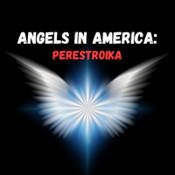
Overview
Synopsis
Perestroika follows on chronologically and plot-wise from Millennium Approaches. It is a complex play that provides a symbolic and fantastical examination of homosexuality, race, and AIDS in 1980s America. The play is made up of eight main characters, all of whom play several other minor characters (of both sexes) throughout. It focuses on the story of Prior Walter, a gay man living with AIDS who has recently been left by his partner, Louis, after he could not cope with the physical and personal impact of the disease. The play opens as Prior is visited by the Angel who has come to make him the prophet for the Great Work designed by the angels above to save the human race. Prior’s rejection of this role underpins the key message of the play: that in the midst of tragedy, mankind keeps moving forward and must keep evolving in order to sort out the destruction it leaves behind. Interlinked with Prior are his ex-partner Louis, who has started a confused relationship with married Mormon lawyer Joe, and Harper, who is married to Joe and possesses the other-worldly vision (or “Threshold of Revelation”) that Prior also has. Prior is unwittingly assisted in his road to revelation by Hannah Pitt (Joe’s mother), who arrives from Salt Lake City to take care of Harper when Joe begins his affair with Louis. Aside from Prior’s journey, the play also contends with the death of Roy Cohn, a real life attorney and key power broker during the McCarthy era. He is dying from AIDS and is visited in his final hours by Ethel Rosenberg, who wants to be the one to tell him of his disbarment and ultimate professional demise. The play ends on a note of optimism as Prior tells the audience that, while AIDS has killed many, there are many more struggling on, living life out of the shadows and keen to be heard.
Show Information
- Book
- Tony Kushner
- Category
- Play
- Age Guidance
- Mature Audiences (M)
- Number of Acts
- 5
- First Produced
- 1991
- Genres
- Drama, Dark Comedy, Fairy Tale/Fantasy
- Settings
- Contemporary, Fantasy/Imaginary, Simple/No Set, Spectacle
- Time & Place
- new york city, elsewhere, 1986-1990
- Cast Size
- medium
- Licensor
- Samuel French
- Ideal For
- Mostly Male Cast, Includes Adult, Mature Adult Characters, Medium Cast
Context
Perestroika follows on chronologically from Angels in America: Millennium Approaches but is designed to work as a standalone play (although the two parts are often produced in repertory). First performed as a staged reading by the Eureka Theatre Company in San Francisco in May 1991, Perestroika was then workshopped the following May and a staged reading was produced once more, directed by Oscar
to read the context for Angels in America, Part Two: Perestroika and to unlock other amazing theatre resources!Plot
Act One: Spooj
Scene One
In the darkness a voice is heard announcing the setting of the Kremlin, January 1986. The lights come up on Aleksii Antedilluvianovich Prelapsarianov, the world’s oldest Bolshevik. He muses philosophically on whether the human race is doomed or if it is able to change and reorder the chaos of the world, as he now sees it. At the end of his speech, a crashing sound is heard and the lights come up on Prior cowering in his bedroom, the ceiling broken on the floor,
to read the plot for Angels in America, Part Two: Perestroika and to unlock other amazing theatre resources!Characters
| Name | Part Size | Gender | Vocal Part |
|---|---|---|---|
|
Lead |
Male |
Spoken |
|
|
Supporting |
Female |
Spoken |
|
|
Supporting |
Female |
Spoken |
|
|
Supporting |
Male |
Spoken |
|
|
Supporting |
Female |
Spoken |
|
|
Supporting |
Male |
Spoken |
|
|
Supporting |
Male |
Spoken |
|
|
Supporting |
Male |
Spoken |
Songs
A song with an asterisk (*) before the title indicates a dance number; a character listed in a song with an asterisk (*) by the character's name indicates that the character exclusively serves as a dancer in this song, which is sung by other characters.
Monologues
Scenes
Key Terms
The name used to describe a number of potentially life-threatening infections and illnesses that happen when the body's immune system has been severely damaged by the HIV virus.
An antiviral medication used to prevent and treat HIV/AIDS.
A model representing a scene with three-dimensional figures, either in miniature or as a large-scale museum exhibit.
A series of events in a performance or piece of literature that are a dream experienced by one of the characters.
A style or genre of drama characterized by realism and an absence of theatrical devices. Often associated with the work of Bertolt Brecht.
An artistic piece of work composed of a mixture of different forms or styles
Dislike of or prejudice against gay people.
The name given to the period of time in 1950s America that saw U.S. Sen. Joseph McCarthy produce a series of investigations and hearings in an effort to expose supposed communist infiltration of various areas of the U.S. government.
A member of the Church of Jesus Christ of Latter-day Saints, a religion founded in the US in 1830 by Joseph Smith Jr.
a person regarded as an inspired teacher or proclaimer of the will of God.
The accepted generic term for the LGBTQ+ theatre movement.
A term invented by Tony Kushner to describe momentary flashes of enlightenment, beyond what you can physically see.
The language used by Jewish people in central and eastern Europe before the Holocaust. It is still spoken today, mainly in the US, Israel, and Russia.
Videos
Quizzes
Themes, Symbols & Motifs
Sorry! We do not currently have learning modules for this guide.
Quote Analysis
Sorry! We do not currently have learning modules for this guide.
